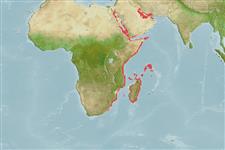>
Acanthuriformes (Surgeonfishes) >
Siganidae (Rabbitfishes)
Etymology: Siganus: Latin, siganus = a fish, rabbit fish; by the similarity of the nose (Ref. 45335).
More on authors: Forsskål & Niebuhr.
Environment: milieu / Klimaatzone / Diepte / distribution range
Ecologie
marien; brak water rifbewoner; diepte 1 - 30 m (Ref. 50672). Subtropical; 32°N - 36°S, 25°E - 58°E
Western Indian Ocean: several localities in East Africa, and from the Red Sea to the eastern Mediterranean via the Suez Canal.
Lengte bij maturiteit / Grootte / Gewicht / Leeftijd
Maturiteit: Lm 13.7 range ? - ? cm
Max length : 30.2 cm TL mannelijk / geslacht onbekend; (Ref. 118092); common length : 20.0 cm TL mannelijk / geslacht onbekend; (Ref. 30573)
Korte beschrijving
Determinatiesleutels | Morfologie | Morfometrie
Dorsale stekels (totaal) : 13; Dorsale zachte stralen (totaal) : 10; Anale stekels: 7; Anale zachte stralen: 9; Wervels: 23. Upper body gray, green or brownish, silvery below; iris iridescent silver or golden. Body color patterns extend to the fins. Spines slender, pungent and venomous. Preopercular angle 88°-96°; cheeks scaled; midline of thorax, isthmus and midline of belly without scales. Frightened fish become mottled or with 6 diagonal zones across side. Tip of broad-based flap of anterior nostril reaching at least halfway to orifice of posterior nostril.
Body shape (shape guide): fusiform / normal; Cross section: compressed.
Inhabits shallow waters and generally in schools of 50 to several hundred individuals; prefers protected areas. Feeds by grazing on algae.
Woodland, D.J., 1990. Revision of the fish family Siganidae with descriptions of two new species and comments on distribution and biology. Indo-Pac. Fish. (19):136 p. (Ref. 1419)
Status op de Rode Lijst van het IUCN (Ref. 130435: Version 2025-1)
Gebruik door de mens
Visserij: van minder commercieel belang; Aquacultuur: commercieel
Tools
Speciale rapporten
Download XML
Internetbronnen
Estimates based on models
Preferred temperature (Ref.
123201): 24.7 - 29.2, mean 27.3 °C (based on 573 cells).
Fylogenetische diversiteitsindex (Ref.
82804): PD
50 = 0.5000 [Uniqueness, from 0.5 = low to 2.0 = high].
Bayesian length-weight: a=0.01175 (0.00969 - 0.01425), b=2.99 (2.94 - 3.04), in cm total length, based on LWR estimates for this species (Ref.
93245).
Trofisch niveau (Ref.
69278): 2.0 ±0.0 se; based on diet studies.
Generation time: 4.0 (1.3 - 4.9) years. Estimated as median ln(3)/K based on 11
growth studies.
Weerstandsvermogen (Ref.
120179): Gemiddeld, minimale populatieverdubbelingstijd 1,4-4,4 jaar (K=0.22, tm=1-2).
Fishing Vulnerability (Ref.
59153): Low to moderate vulnerability (31 of 100).
🛈
Nutrients (Ref.
124155): Calcium = 21.9 [10.0, 56.0] mg/100g; Iron = 0.57 [0.26, 1.33] mg/100g; Protein = 19.5 [18.5, 20.6] %; Omega3 = 0.21 [0.11, 0.45] g/100g; Selenium = 7.41 [2.58, 18.44] μg/100g; VitaminA = 52.3 [14.3, 193.5] μg/100g; Zinc = 1.38 [0.54, 3.02] mg/100g (wet weight); based on
nutrient studies.
